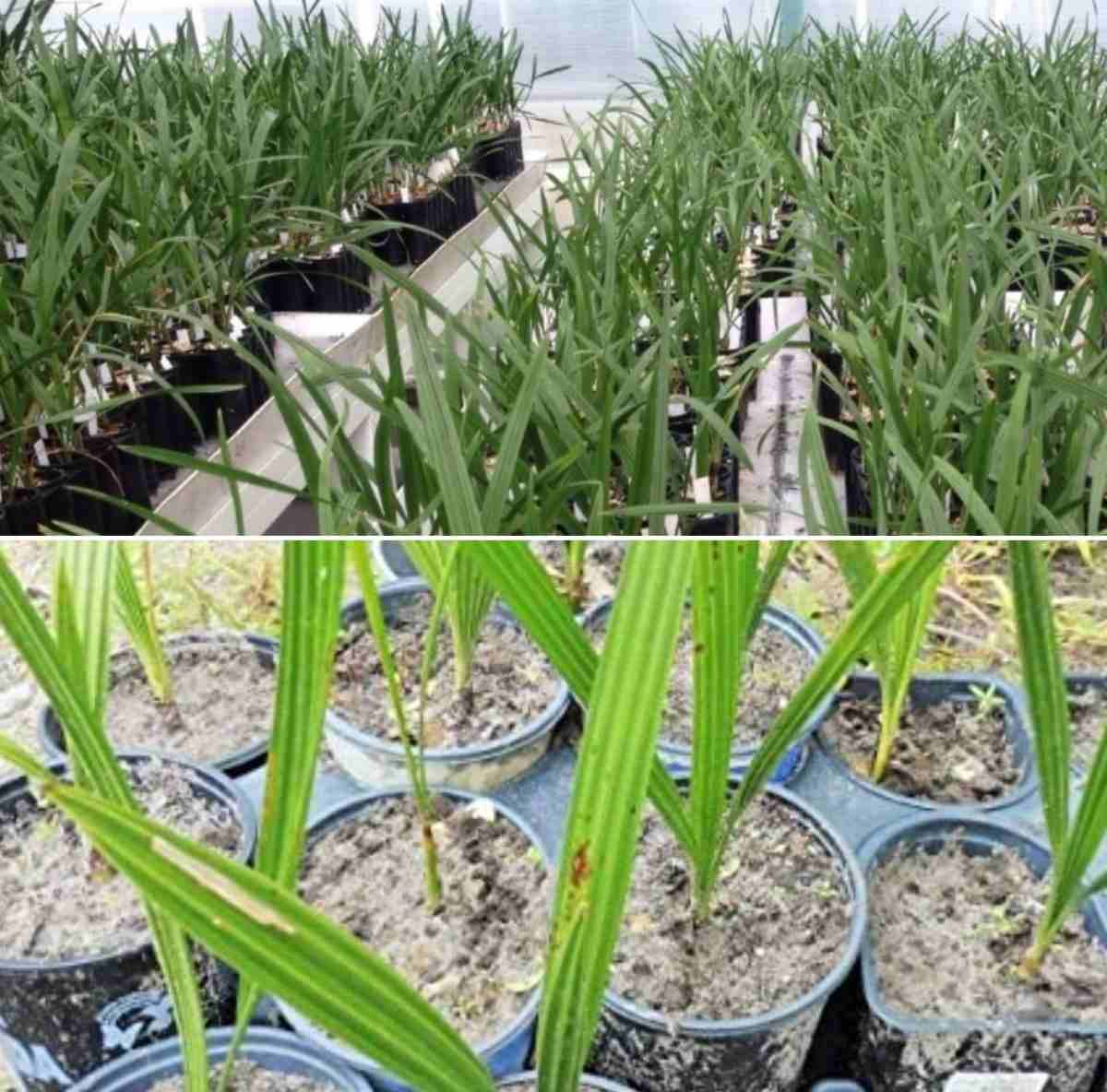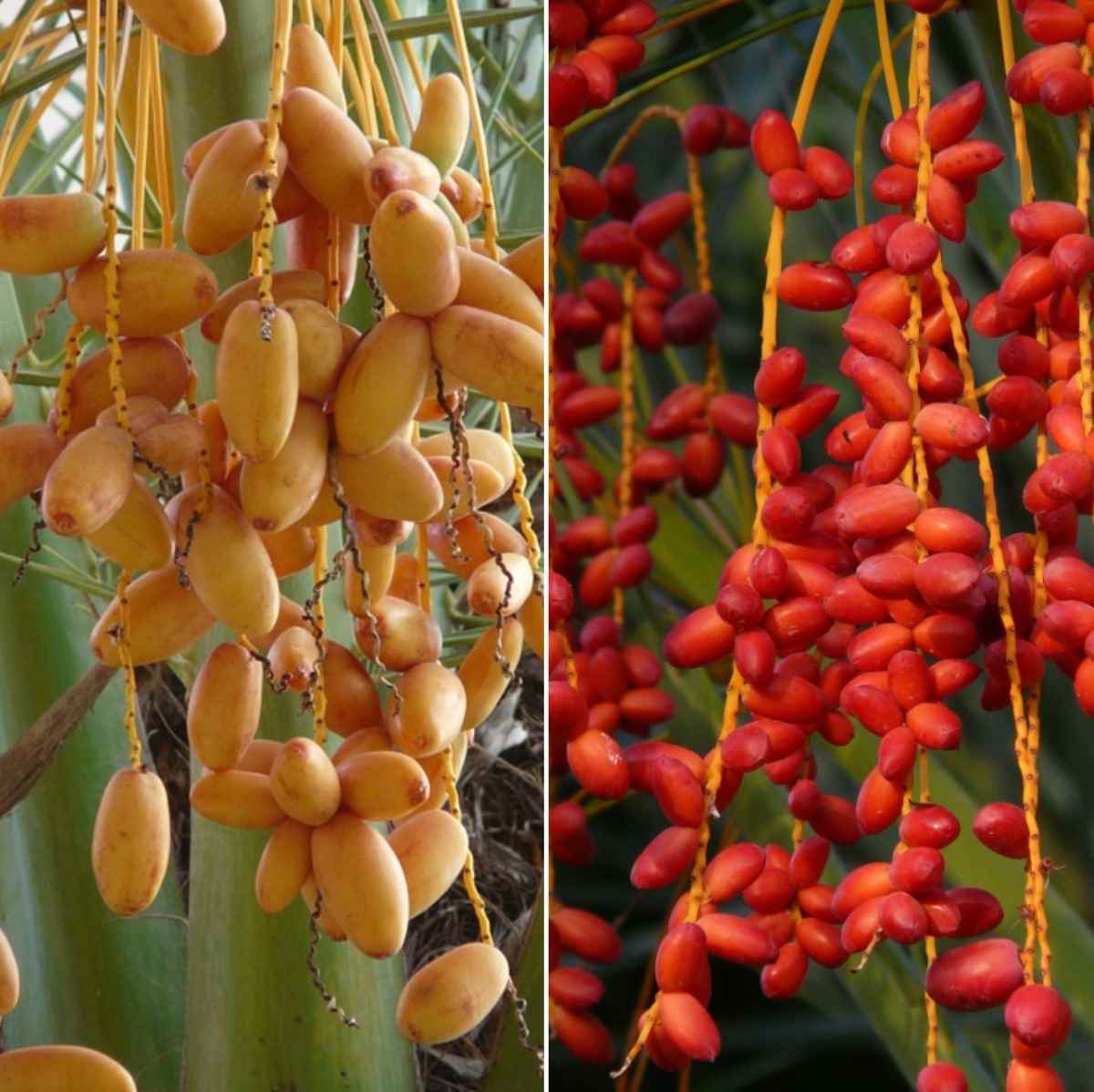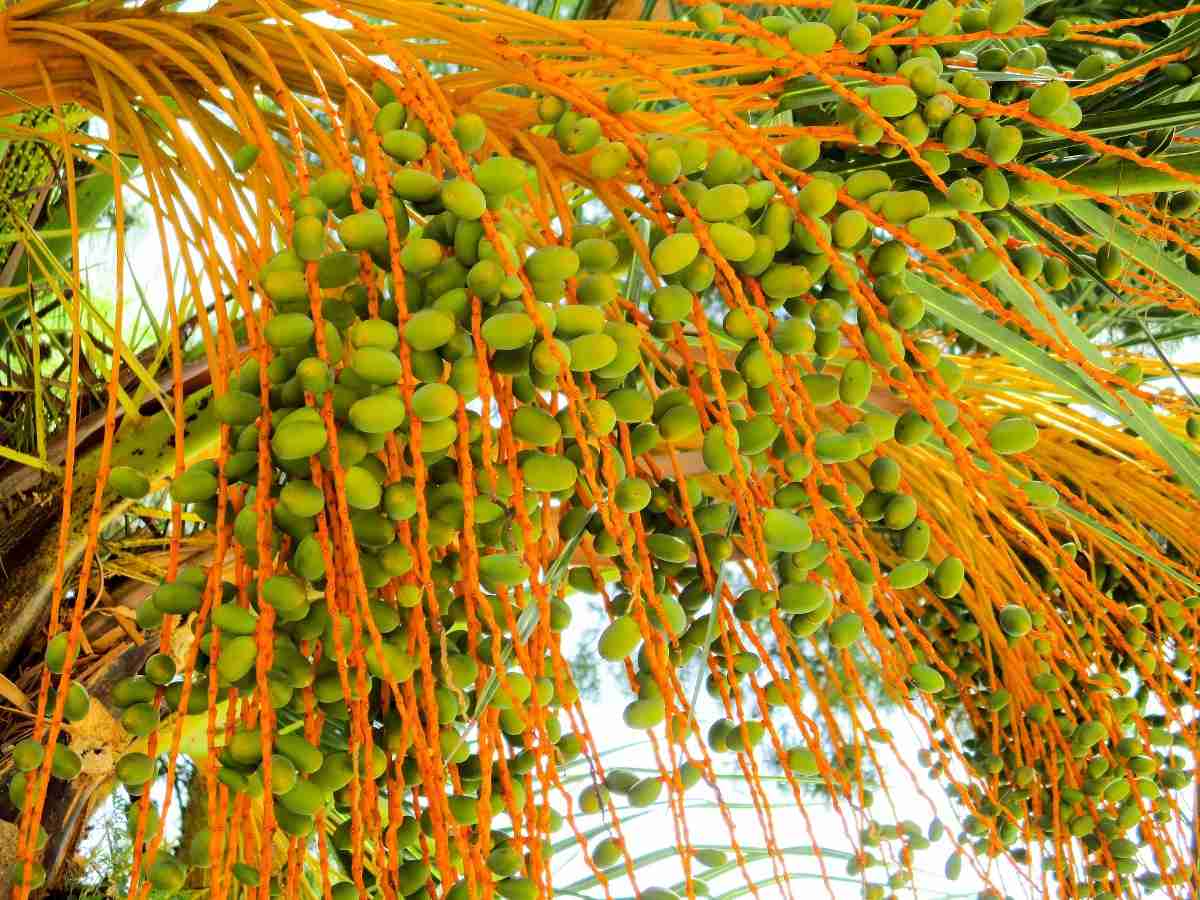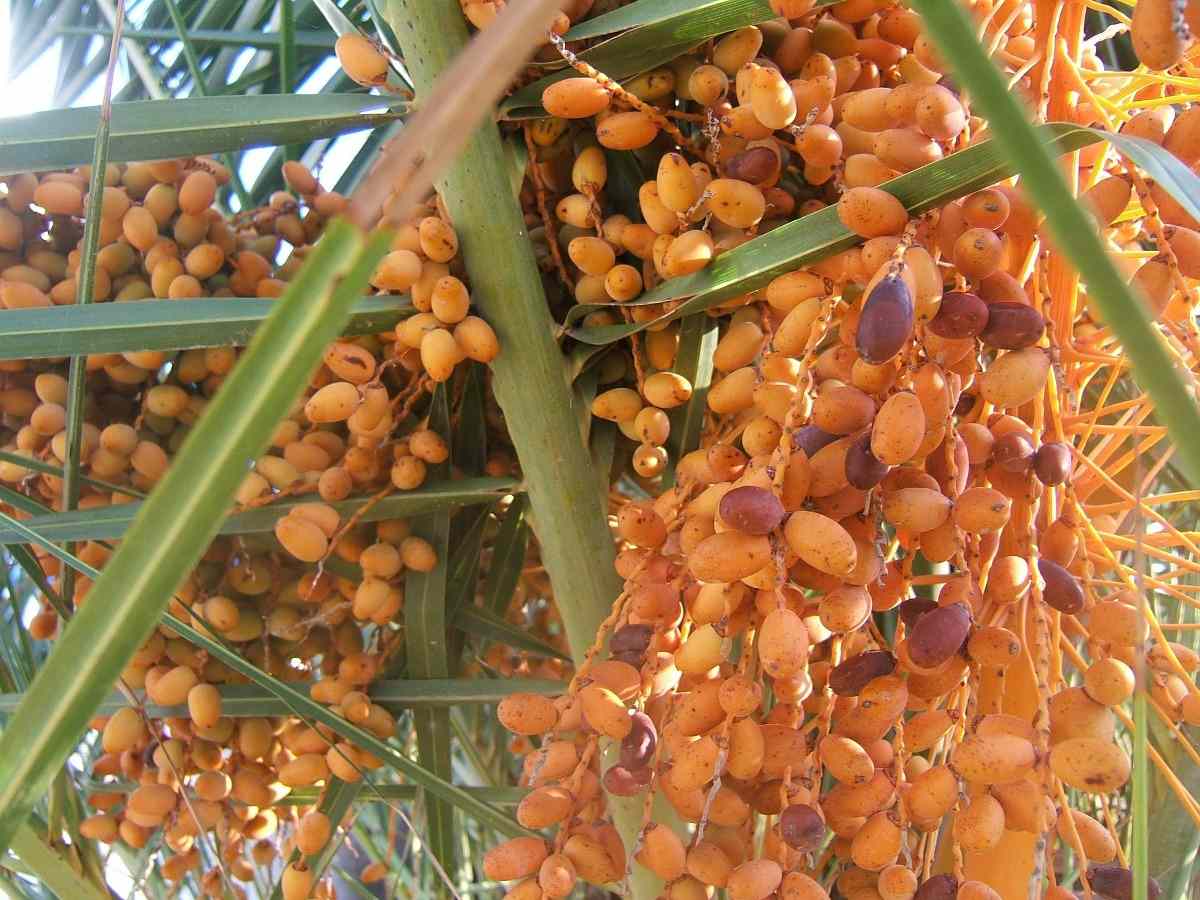Introduction to Date palm seed germination: Date or date palm is a plant species in the palm family, Arecaceae and grown for its sweet edible fruits. Date palms are highly valued because they provide abundant food in a harsh place. Date fruits (dates) are oval-cylindrical, 3 to 7 centimeters long, ranging from bright red to bright yellow, depending on the variety. Date palm fruits are sweet, containing about 75 percent of sugar when dried. Flowers of date palm trees are small and yellow-colored attached directly to spikelets which develop as fruits known as date palm fruits. The trees grow large; produce fruit for a long time, and can survive long droughts and extremely high temperatures. A healthy tree needs the same climate as their seeds require for germination. Although date palms have offshoots you can propagate, growing the Date plant from seed is another option. In this article we also discuss below topics;
- Date palm propagation
- How to make date palm grow faster
- Process of growing date palm from seed
- Time to take date seeds take to germinate
- How do you germinate date palm seeds
- Process for germinating date seeds
- Date seed germination period
- Different types of date palm seed germination
- How fast do date palms grow
- Date seed germination conditions
- Date seed germination temperature
A step by step guide to date palm seed germination
The fruit of the date palm tree contains tannin, which makes it an effective astringent. The date palm fruit from the tree has been used to treat sore throats, colds, bronchial catarrh, fevers, gonorrhea, edema, and abdominal problems. The seeds from the date tree have been ground into a paste that is effective in treating ague.

Types of date palm seed germination
The way date palm seeds germinate falls into one of two categories. They are;
- Remote germination
- Adjacent germination
In date palms with remote germination, the seedling axis develops at some distance from the actual seed. The first structure to emerge from the seed is known as the cotyledonary petiole. The cotyledonary petiole grows downward into the soil (sometimes deeply) and then swells at its base. From this swelling emerges the first seedling root or radicle and seedling shoot. The actual seed leaf remains inside the seed, functioning as an absorptive organ called the haustorium. The haustorium transfers major nutrients from the endosperm to the young seedling. In date palm seeds with remote germination, the radical persists for some time and produces lateral roots. The date seeds of Mediterranean fan palms, Chinese fan palms, date palms, and Mexican fan palms have remote germination.
You should not miss the Organic Farming Business Plan, Profitability, Schemes.
The other main class of date palm seed germination is called adjacent germination. In these seeds, a small portion of the cotyledon emerges from the seed. It appears as a swollen body abutting the seed surface and it is called the “button.” The radical and plumule emerge from the bottom and top of the button. In palms with adjacent germination, the first seedling root is narrow and short-lived and quickly replaced by roots formed at the seedling stem base. As with the remote germination process, a haustorium remains inside the seed absorbing food from the endosperm. Some common palms with adjacent germination contain areca and Alexandra’s palm.
Conditions for date palm seed germination
Temperature for dates seed sprouting
Virtually all palms need high temperatures for the most rapid and uniform germination of their seed. 70 to 100°F is the accepted range, and 85 to 95°F probably yields the best results. If the availability of fresh seed makes this difficult, soil temperature ranges can be increased by using bottom heat below the germination containers or by covering the containers with clear plastic. Placing the containers on a heat-retaining surface can increase temperatures by several degrees.
Light requirement for date seed germination
Many palms germinate in the understory of a forest canopy in their native habitats, even if they grow up into the full sun. Seedlings of these species can be germinated in full sun, but their leaves can bleach to some extent under those conditions. Many growers feel that, despite the bleaching, root growth and overall seedling growth are enhanced in full sun. Under the shade, seedlings will have a deeper green color.
Irrigation for date seed germination
Palm seeds require uniform moisture during the first critical stages of date germination when the cotyledonary petiole (in remote germination) or button (in adjacent germination) first emerges from the date seed. Alternating periods of extreme wet and dry during this period will have deleterious effects on total germination percentages. If the germination substrate does not receive some type of automatic irrigation, it can be necessary to cover the containers with clear plastic to retain adequate soil moisture. Overwatering trees can be equally deleterious. At no time should standing water be visible on the surface of the seed germination substrate.

Date palm germination environment
A temperature or humidity-controlled greenhouse environment is ideal. This offers more heat, higher low-temperature ranges, and more consistent humidity. There is less risk of predators, weed contamination and weather-related problems. A simple warming device that is a light bulb can be utilized.
In case if you miss this: Basil Pests and Dieases, Control Methods.
If not utilizing a greenhouse or germination box, provide seeds with the warmest area possible with good humidity and away from direct, hot sunlight. Filtered light is preferred for germinating date palm seeds. Humidity levels of about 60 to 70% are ideal. Avoid overly damp locations or rot will develop.
Sowing date palm seed
Containers
A variety of germination containers can be used for palms seeds, for example, pots and flats. Pots are better than flats because of the deeper soil column and better drainage. For deep-rooted species, and particularly those that bury the seedling axis, tree tubes, lengths of PVC pipe, or other improvised containers have been used to give the extra depth that these seedlings need during early development. Some growers choose to sow seed in large raised beds constructed from wood or cinder blocks. The important consideration for any germination container is that it allows adequate drainage of excess water from the substrate.
Substrate
Palm seed germination substrates should be well-drained, yet have some moisture-holding capacity. A pattern of alternate extremes of dryness and wetness is detrimental to seeds during seed germination. Particle size in the substrate must not be excessively large or prone to separation with repeated irrigation. About 1:1 mixture by volume of peat moss and perlite has been successfully used under a wide range of nursery conditions. The mix in a germination substrate must be adjusted depending on the conditions to which the seed will be exposed. For example, the seed germinated in full sun will need a substrate with higher water holding capacity than seed germinated under the shade, all other conditions being equal.
Date palm seed germination techniques

Community Pots or Beds
This is a method by which seeds are sewn in a container or bed, usually many seeds placed side by side in the germinating soil. This is a commonly used technique. It is more space-efficient. This method is good for day to day observation and offers a grower the opportunity to remove seedlings at will. These seeds are easily seen and followed when germinating and easy to remove from their pots. This is the frequently used technique by commercial growers.
Advantages – Easy observation, erect seedlings, good air circulation, easy application of chemicals, application of bottom heat, and independent removal of seedlings as needed.
Disadvantages – Somewhat more difficult to set up, the potential for less heat, greater desiccation risk, a chance for collateral contamination by fungus.
“Baggie” Technique
It is an easy technique of placing seeds with some slightly damp moss into a transparent plastic baggie and putting the baggie in a warm environment, such as near a water heater.
Advantages – Improved humidity, inexpensive, simple, space-efficient, and good for small numbers of seeds.
Disadvantages – Poor visibility, twisted seedlings, the potential for rapid fungal demise, lack of ventilation, inferior light, risk of under-hydration without warning, and need for timely removal when ready or one gets seedling spaghetti.
You may also like the Seed Subsidy Schemes for Farmers in India.
Sprouting the date palm seed
Purchase dates at grocery stores and opens them up to remove the seeds from the center. Then, set the seeds aside and either eat or discard the date fruit. Clean off the seeds to remove any leftover date fruit. Rinse the seeds thoroughly and then rub off any excess date flesh. If the leftover fruit is persistent, you can soak the seeds in hot water for about 24 hours, and then rub off the fruit.
Soak the pits in freshwater for about 48 hours. Fill a cup or bowl with cool water and put the pits inside to soak. Then, change the water once a day by dumping out the old water and refilling it with fresh water. This will help keep mold from forming. Seed coat absorbs the water and prepares it for the seed germination process. Fold 2 seeds into a damp piece of paper towel and run some water over a sheet of paper towel to dampen it. Then lay the paper towel out flat and place two date seeds on either end. Fold the paper towel over so it covers both seeds, and fold it in half. The seeds must be fully covered and separated by a layer of paper towel.
Put the seeds and paper towel into a plastic bag and seal it. Then open up a plastic sandwich bag and tuck the damp, folded paper towel inside. Make sure the date seeds are still in place before closing the bag’s seal. Store the bag in a warm, dark place for 6 to 8 weeks. The seed will germinate best at temperature ranges between 70 to 75°F (21 to 24 °C). Find a place in the home that stays warm, such as the top of the refrigerator, or use a warming mat to regulate the temperature more carefully.
Check the plant regularly for growth progress. Every 2 weeks, open the bag up and check for progress. Check for mold as well, taking care to replace mold paper towel with a fresh damp paper towel. After 2 to 4 weeks, you should see tiny roots growing out of the seed.
Pot the seed once it sprouts. Keep checking the germinating seed for growth progress. Once the seed has sprouted a shoot-off of the roots, it is time to take it out and pot it. Try sprouting the date seeds in pots if you’d prefer them in containers. Prepare a pot for each seed by filling the pots with one part seed-starting compost and one part sand. Lightly water the soil so it’s moist and then plant the date seeds so half of each seed is exposed. Cover the exposed part of the date seed with sand. Cover the pots with plastic wrap and put them somewhere with indirect sunlight that has a temperature of around 70 °F (21°C). The seeds should sprout after 3 to 8 weeks. Put the pots on a germination mat if you’re having trouble finding a spot that’s 70 °F (21 °C).
Growing date palms from seed
This process is quite easy but yielding fruit from your trees will be a bit more challenging. To grow a palm simply eat a date, remove the seed and wash it clean of any excess flesh.
Next soak the date seeds in water for at least 24 hours (or 48 hours), which will allow the strong seed coat of the date seeds to imbibe water. There are several methods for germinating date seeds, but there are two easy methods for most date seeds. The first is to sow the date seed (rough side down) about one inch into a small pot filled with soil. Lightly water the soil occasionally ensuring moisture at the seed’s depth, as being careful not to over-water the soil.
You may also check this: Plant Nursery Project Report for Bank Loan.
The second process is to wrap the date seeds in a slightly moist paper towel and put them in a plastic bag. Put the bagged seeds in a warm place, at least 75°F and small white roots will begin to appear from one side of the date seeds. The germinated date seeds may then be planted in a small or medium-sized pot filled with a palm or cactus potting soil.
Date seeds are picky when it comes to moisture, they want to be slightly moist so be sure not to overwater the seeds. Other germination methods work better for tricky seeds, and these contain the incorporation of sand and vermiculite to help regulate the moisture of the soil.
Date palm seed germination time
Viable date tree seeds germinate between 14 and 21 days in ideal conditions. Choosing fresh fruits from a healthy date tree, and removing the seeds promptly, give you a better chance at seed germination success. If the ideal conditions are not met, healthy date seeds could take as much as 100 days to germinate.
Germination medium for date palm seed
Seed germination success depends largely on the growing medium and it must have a steady temperature and texture during the germination process so the seed is not stressed. An even ratio of perlite to peat moss acts is the best medium for date palm seed germination. Date palm seeds need temperatures consistently above 70°F to stimulate the seed to break through its shell or coat.
It should provide a root substrate, moisture, nutrients, and aeration. It is ideally loose enough for easy penetration of seed germination radical. It accepts water easily and not dry out too quickly. There are different opinions on the ideal mix. The mix can be made by hand or purchased as a seed germination mix. Normally used are mixtures of perlite and peat moss in a 2:1 or 3:1 ratio. Wetting agents are added to the medium to help with watering. Pure peat moss could be used but can turn into a hard block if ever allowed to fully dry out.
Frequently asked questions about date palm seed germination

How long does a date seed take to germinate?
Viable date palm seeds germinate between 14 and 21 days in ideal conditions.
Can you grow a date tree from the pit?
Dates palms can also be grown from seed. To grow a date tree from a date pit, then soak several date seeds for a week in cold water, changing the water daily to prevent mold or bacterial contamination. While you don’t know which seeds will germinate and which won’t plant several seeds in one pot.
Can you grow dates from a date seed?
The seeds from dates can grow into date trees that you’ll be able to enjoy in-home, porch, or garden. Simply collect and wash the pits from some dates, then let them germinate for a couple of months. Once the date seeds sprout, you can plant them in a pot of soil.
How long does it take to grow a date palm tree?
Date palms can take 4 to 8 years after planting before they will bear fruit, and start producing viable crop yields for commercial harvest between 7 and 10 years.
You may be interested in Making Chicken Manure Compost for Garden Plants.
Very helpful. Kudos to you for coming back to farming.
respected sir my name is Mr sharif MS i want dates farming guideline complete pl send me data
Very Thankful …. Pls Provide Detail info on Male Female Plant, Identification and Pollination